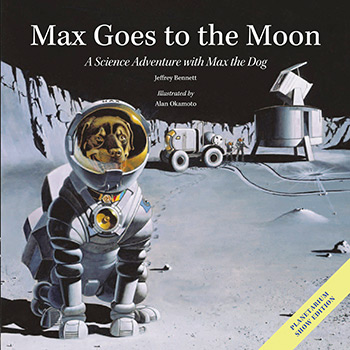Category: Children’s Book
Reviewed by: Marianne Dyson
Title: Max Goes to the Moon
Author: Jeffrey Bennett
Illustrator: Alan Okamoto
Reading Level: Ages 4-8
NSS Amazon link for this book
Format: Hardcover
Pages: 32
Publisher: Big Kid Science
Date: 2003
ISBN: 0972181903
Max Goes to the Moon is about a dog who is being honored with a parade for having rescued the space station crew (apparently in a previous book). During the parade, Max howls at a siren. Reporters think he’s howling at the Moon because he wants to go there. The public insists that he go, and so he and his owner, a girl named Tori, and 6 astronauts train for a Moon trip. They fly to the space station where they pick up their ship to go to the Moon. They land, romp around a little, and leave the Moon after 12 days. Billions of children watch the trip and urge the adults to build a big-domed Moon colony. The adults are persuaded and put a telescope and a University there where, “Students and scientists made important new discoveries every day.”
Adults will realize that it isn’t even remotely possible that the first trip back to the Moon will include a child and a dog. They will also know that by the time a new Moon lander (and a doggie spacesuit) is approved, designed, built, tested and flown, the child would be grown up and the dog long dead. Establishing a lunar colony will take much much longer. However, science fiction based in our universe needs only to be possible, not practical. I fully agree with the author’s choice not to worry about these things (a zillion-dollar budget could work miracles!) so the story can move at a pace more suitable to a child’s perception of time.
Every page of this book has a sidebar box explaining the science behind the story. The information covers the usual Moon topics such as phases, as well as descriptions of such things as how rockets and telescopes work. It was a real pleasure to read these sidebars and not find any errors. As a scientist and technical reviewer, I agree with the cover blurb stating that, “You can always trust Big Kid Science products to be scientifically accurate…” The author really knows his science.
That said, I felt that the sidebars were too wordy and detailed for the 4-8 age group. The type size is extremely small and intimidating and sentences are long and complex. An adult would be required to read these to the child. It is difficult to say that any of this rich material should be cut, but it really belongs in a book for the 8-12 crowd.
The story stands alone without the sidebars except for when Max goes after a Frisbee. It says that he positions himself under it for the catch, and “There was only one problem…” I turned the page expecting to find out what the problem was, but the next paragraph has nothing to do with the Frisbee. To find out what the problem was, the child must read the sidebar explaining that because of the lack of air, the path would not be curved. This might mean that the problem was that Max went to the wrong place. But the problem may have been that he couldn’t catch it with a helmet on as shown in the picture. Maybe there could be Velcro on the Frisbee and on the helmet near Max’s mouth?
My primary disappointment was that a dog and child go to the Moon and nothing really happens. There is no problem for the dog and child to solve, no danger to overcome, no difficult lesson to learn. Without a challenge of some sort, there was also no sense of triumph for the historic accomplishment of returning to the Moon.
On the other hand, the illustrations may well lure a child to reopen the book again and again. They are vivid and full of energy. They also include realistic details such as not showing stars in the black sky above the Moon’s sunlit surface. My favorite picture is of the crew struggling to get an excited Max into his spacesuit. Every child who has put a sweater or costume on a pet will relate to this difficulty. I also adored the UFO-looking design of the lander. (Can we build one of those, Mommy, please?!)
The only minor technical mismatch between the text and illustrations is in two consecutive images of Earth showing it growing from crescent to not quite first quarter. The text says that they spend about 10 days on the moon. The Earth would grow from crescent to gibbous in 10 days. However, the important thing is that phasing is shown at all, and the two pictures could represent times closer together than 10 days. A nice detail I noticed is that the Earth appears in these pictures with the day lit side on top as it would appear from sites near the equator. If the Earth were a vertical crescent, it would mean the site were at a high latitude. The return opportunities from high latitudes to the space station’s orbit occur only every 37 to 42 days (unless a new kind of propulsion is developed), whereas from the Moon’s equator, the opportunities are about every 10 days, consistent with the story. Also, the Earth appearing midway between the horizon and zenith is consistent with them landing near the western limb of the near side. A western landing is required for them to be in daylight for 10 days and have the Earth in the phase shown.
I recommend Max Goes to the Moon as a scientifically-accurate and a wonderfully-illustrated book for young children.
© 2006 Marianne Dyson
Please use the NSS Amazon Link for all your book and other purchases. It helps NSS and does not cost you a cent! Bookmark this link for ALL your Amazon shopping!



















